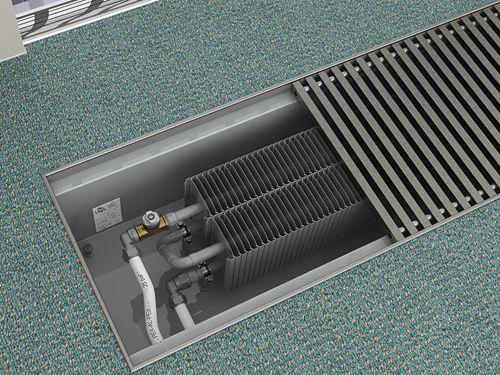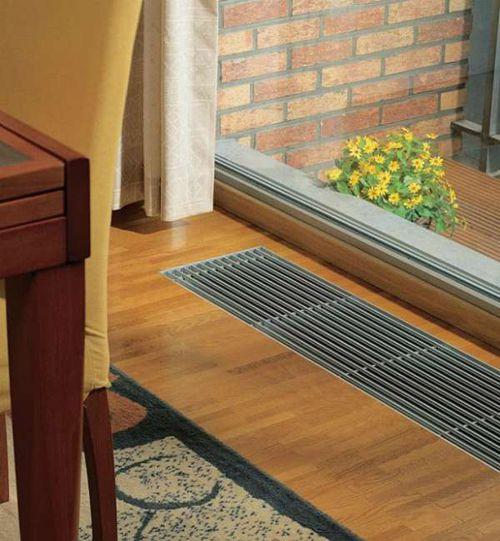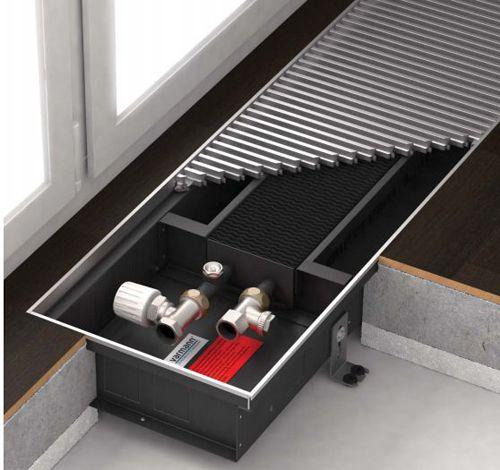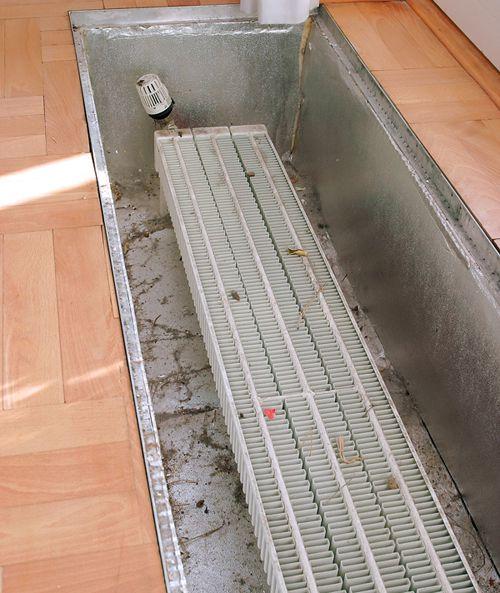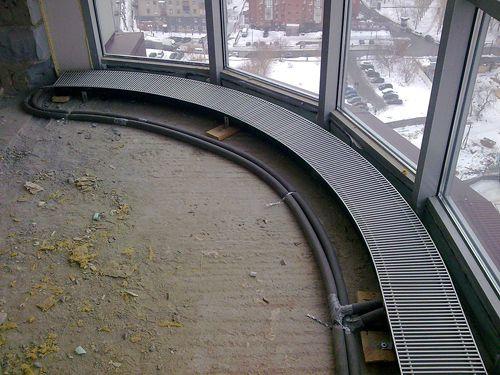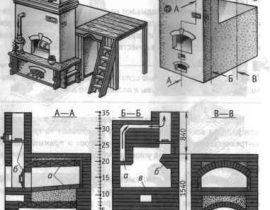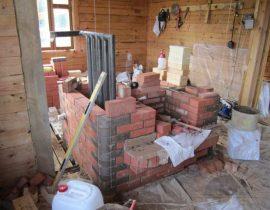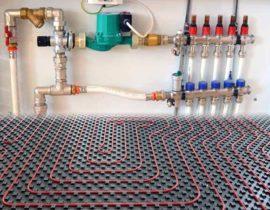Underfloor heating floor convectors are floor heating devices that can be connected to a local or centralized heating system. They look like a box with a coil placed inside and closed with a grill and are installed in front of balcony doors or French windows, under which conventional radiators cannot be installed. The principle of operation of convectors is quite simple: the air heated inside the duct rises through the grate into the room, and heavier cold air enters in its place, that is, their operation is based on the principle of convection.
Content
Floor convector or its analogue - a warm floor, which is better?
If we consider the features of heating a room with a convector and a warm floor, we can note:
- Water heated floors can operate within a certain temperature and pressure range, which is difficult to provide in apartments with central heating. In high-rise buildings with a forced heating system, the pressure reaches 15 bar, which is unacceptable for warm floors - cracks in pipes, leaks, and destruction of the flooring may appear.Convectors, in which the coil is made of copper pipe, can withstand such pressure for a long time and without damage.
- To install a warm floor, you must observe the minimum and maximum length of the circuit, they cannot be mounted in a small area or a separate gap, for example, in front of a window or balcony door. Convectors can be mounted anywhere.
- Some types of decorative flooring are extremely susceptible to general temperature changes, for example, natural wood parquet begins to dry out after a couple of years when installing underfloor heating, especially when connected to centralized heating with a coolant temperature above 40 degrees. Convectors are installed in those places where intensive heating is required, while the flooring in the rest of the room does not heat up.
- If the convector fails, it can be easily repaired or replaced without opening the floors. With a warm floor, such an operation is impossible, you will have to dismantle it over the entire area of \u200b\u200bthe room.
Thanks to all the features described, underfloor heating floor convectors are confidently gaining popularity among urban residents and owners of private houses. They can be installed as independent heating devices or together with conventional radiators.
The device and appearance of the floor convector with a fan
Convectors are a case in the form of a tray or box made of metal with anti-corrosion properties or a coating, inside which a heat exchanger is installed - a copper coil with aluminum fins that increase the heat transfer area. The coil has a fitting for connection to the heating system.The top of the box is closed with a grate that can be made of different materials and in different styles, combined with traditional decorative flooring. The box rests on adjusting bolts designed to level the convector.
Operating principle
The principle of operation of the convector is extremely simple: cold air from the floor surface enters the duct, where it heats up due to heat transfer from the aluminum coil plates. Lighter heated air rises through the grate, and a new portion of cold air enters in its place. This process takes place continuously, as a result, the air around the convector has the same comfortable temperature. Some powerful models are equipped with a fan that forcibly increases the heat exchange rate.
Selecting the power of a water floor convector
Any heating devices are selected according to their thermal power, that is, the ability to maintain a given temperature in the room. Convectors are no exception; before installing them, it is necessary to calculate their power. The calculation is not much different from the calculation of conventional radiators. Execute it like this:
- Determine the size of the room and its area - the product of the sides, expressed in meters. For example, a rectangular room with dimensions of 4x6 meters has an area of 24 square meters.
- Multiply the resulting area by 100 and get the heat output necessary for its heating, expressed in watts (W). For the example above, this value is 2400 watts.
- The number of convectors is determined depending on the places of their installation.You can install them only in front of the balcony doors and supplement them with radiators, or you can perform all the heating of the room with convectors. For the room in question, for example, four floor convectors of the MINIB COIL-P80-2500 brand with a power of 650 W each will suffice.
It is better to choose convectors with a small margin of power, since the passport characteristics are designed for the ideal parameters of the heating system, which is not always the case in reality.
Water convector installation
- Most convector models have a thickness of no more than 10 cm, so they can be easily integrated into a finished floor screed. Installation is done like this:
- The floor convector is placed on the subfloor over the waterproofing in the place intended for it and fixed with the help of corners and screws included in the kit. The corners are attached to the draft floor with dowels and screws.
- Align with the help of adjusting bolts its position. To do this, the bolts are screwed into the holes at the corners of the bottom of the box and, using a level, raise each corner to the desired height. The corner, which fixes the convector to the floor, allows you to do this due to the longitudinal hole.
- Connect the convector to the heating system according to the selected scheme. Fittings are used for connection. Corresponding to the type of pipes used. Copper pipes are considered more reliable. Install a pressure regulating servo on a tee attached to a straight pipe. Pipes extending from the convector and connecting it to the heating system are placed below the level of the screed and are thermally insulated to reduce heat loss and to avoid overheating of the floor screed.
- Insulation is laid, usually polystyrene foam is used.Reinforcement is performed, after which the screed is poured, leveled and dried. The convector box must first be covered with a dense material that prevents the solution from getting inside.
- Apply or lay the floor finish. Install a protective grille on the convector.
Thanks to various sizes, convectors can be installed in any room, including glazed loggias and terraces. By connecting several convectors in series, it is possible to create a heating circuit along the glass walls.
You can clearly see the installation process of the convector in the video.
Video - installation of the Varmann floor convector
How to maintain a floor convector?
Like any other heating equipment, underfloor heating convectors need periodic cleaning. It is performed with a vacuum cleaner, after removing the protective grille. Clean the finned surface of the heat exchanger, if necessary using a brush, remove dirt and dust. The grid itself can be washed with water.
During hydraulic tests, when the pressure in the heating system exceeds the nominal one, it is necessary to make sure that the convectors do not leak. To do this, just open the grate and inspect the box. If it is dry, it means that the convector passed the test with honor.
Subject to the installation and maintenance rules, underfloor heating water convectors will bring warmth to your home without violating the overall design idea. The convector installed in front of the front door is able to retain up to 90% of cold air when it is opened and create a thermal curtain.At the same time, they are silent, look stylish and, thanks to the variety of colors, fit perfectly into any interior, giving coziness and comfort.
With fan or without?
Fans on floor water convectors significantly increase the power of the system as a whole, as they force air through the radiators. With the use of fans, you can absolutely precisely control the volume of passing air and, accordingly, the air temperature in the room. Of course, such a system upgrade will turn a little more money out of your pocket, but if you are ready to spend money for more comfort, feel free to install it, you won’t lose!

